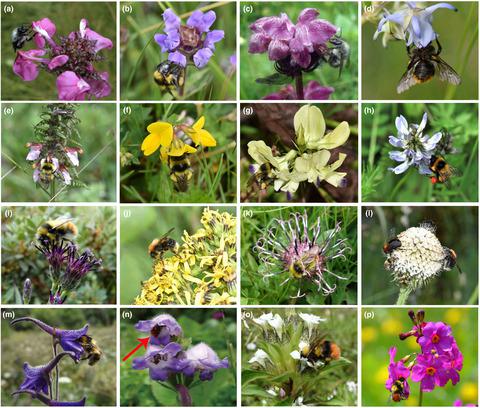当前位置:
X-MOL 学术
›
Funct. Ecol.
›
论文详情
Our official English website, www.x-mol.net, welcomes your feedback! (Note: you will need to create a separate account there.)
Evolutionary and ecological factors structure a plant–bumblebee network in a biodiversity hotspot, the Himalaya–Hengduan Mountains
Functional Ecology ( IF 5.2 ) Pub Date : 2021-07-22 , DOI: 10.1111/1365-2435.13886 Huan Liang 1 , Yan‐Hui Zhao 1 , Nicole E. Rafferty 2, 3 , Zong‐Xin Ren 1 , Li Zhong 1 , Hai‐Dong Li 4 , De‐Zhu Li 5 , Hong Wang 1
中文翻译:

进化和生态因素构建了生物多样性热点喜马拉雅-横断山脉的植物-大黄蜂网络
更新日期:2021-07-22
Functional Ecology ( IF 5.2 ) Pub Date : 2021-07-22 , DOI: 10.1111/1365-2435.13886 Huan Liang 1 , Yan‐Hui Zhao 1 , Nicole E. Rafferty 2, 3 , Zong‐Xin Ren 1 , Li Zhong 1 , Hai‐Dong Li 4 , De‐Zhu Li 5 , Hong Wang 1
Affiliation

|
- Species interactions, such as those between plants and pollinators, are known to be shaped by both evolutionary history and ecological factors. However, little is known about how multiple factors (e.g. phylogeny, phenology, abundance and functional traits) interactively affect interaction patterns.
- Using a plant–bumblebee network comprising 2,428 interactions between 29 plant species and 12 bumblebee species in the Himalaya–Hengduan Mountains, we tested for phylogenetic signal and whether phylogenetic pattern was explained by abundance, phenology and 13 plant and bumblebee functional traits. We also tested whether trait matching in two pairs of plant–bumblebee traits explained interaction frequencies at both species and individual levels.
- The network showed significant phylogenetic signal; closely related bumblebees tended to visit similar sets of plants, but not vice versa. Among all the measured factors, nectar volume and sugar concentration, rather than other phylogenetically constrained factors, were most important for explaining phylogenetic pattern (64% and 54% respectively). Although long–tongued bumblebee species tended to interact with long–tubed flowers, trait matching did not predict short–tongued bee interaction frequencies. Despite this, trait matching was apparent at the level of individual bees, reflecting intraspecific variation in tongue length and body size. Different selection pressures may exist within this bumblebee community, resulting in specialized, co–evolved traits in long–tongued species and adaptive generalization in short–tongued species to gain access to a variety of flowers.
- Together, these findings contribute to our understanding of phylogenetic trait–based structure in species interaction networks. In particular, this study provides new evidence for the importance of nectar rewards in structuring interaction patterns in pollination mutualisms. The results also demonstrate that trait matching may occur at the individual level, despite not being detectable at the species level, and underline the necessity of taking intraspecific trait variation into account in studies of community structure.
中文翻译:

进化和生态因素构建了生物多样性热点喜马拉雅-横断山脉的植物-大黄蜂网络
- 物种相互作用,例如植物和传粉者之间的相互作用,已知受进化历史和生态因素的影响。然而,关于多种因素(例如系统发育、物候、丰度和功能性状)如何相互作用地影响相互作用模式,我们知之甚少。
- 使用包含喜马拉雅-横断山脉 29 种植物和 12 种大黄蜂之间 2,428 种相互作用的植物 - 大黄蜂网络,我们测试了系统发育信号以及系统发育模式是否可以通过丰度、物候学和 13 种植物和大黄蜂功能性状来解释。我们还测试了两对植物 - 大黄蜂性状中的性状匹配是否解释了物种和个体水平的相互作用频率。
- 该网络显示出显着的系统发育信号;密切相关的大黄蜂倾向于访问相似的植物群,但反之则不然。在所有测量的因素中,花蜜量和糖浓度,而不是其他系统发育限制因素,对于解释系统发育模式最重要(分别为 64% 和 54%)。尽管长舌大黄蜂物种倾向于与长管花相互作用,但性状匹配并不能预测短舌蜜蜂的相互作用频率。尽管如此,特征匹配在个体蜜蜂的水平上很明显,反映了舌头长度和体型的种内变化。在这个大黄蜂社区中可能存在不同的选择压力,导致专门的、
- 总之,这些发现有助于我们理解物种相互作用网络中基于系统发育特征的结构。特别是,这项研究为花蜜奖励在构建授粉共生中的相互作用模式中的重要性提供了新的证据。结果还表明,性状匹配可能发生在个体水平,尽管在物种水平上无法检测到,并强调了在群落结构研究中考虑种内性状变异的必要性。



























 京公网安备 11010802027423号
京公网安备 11010802027423号